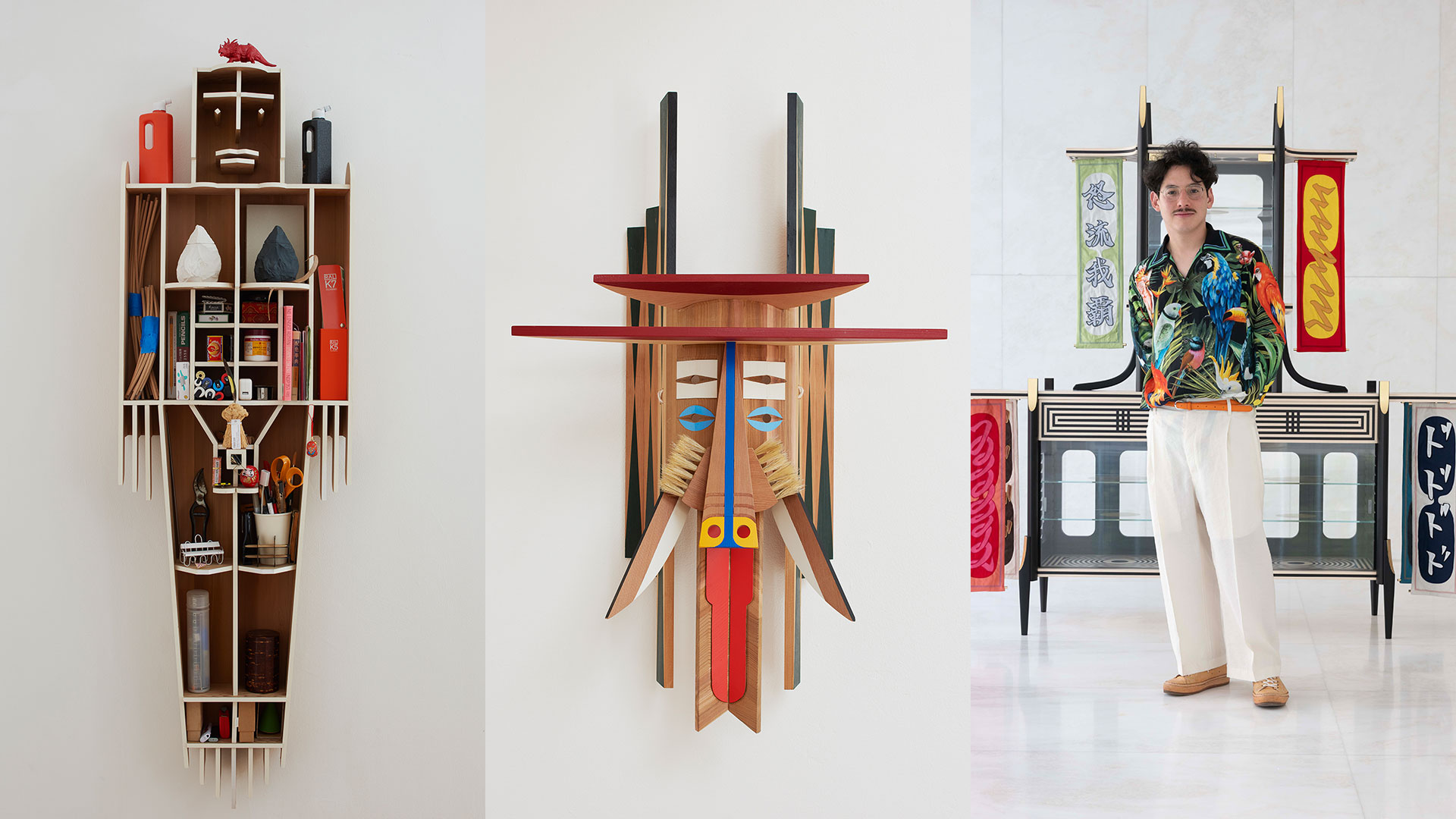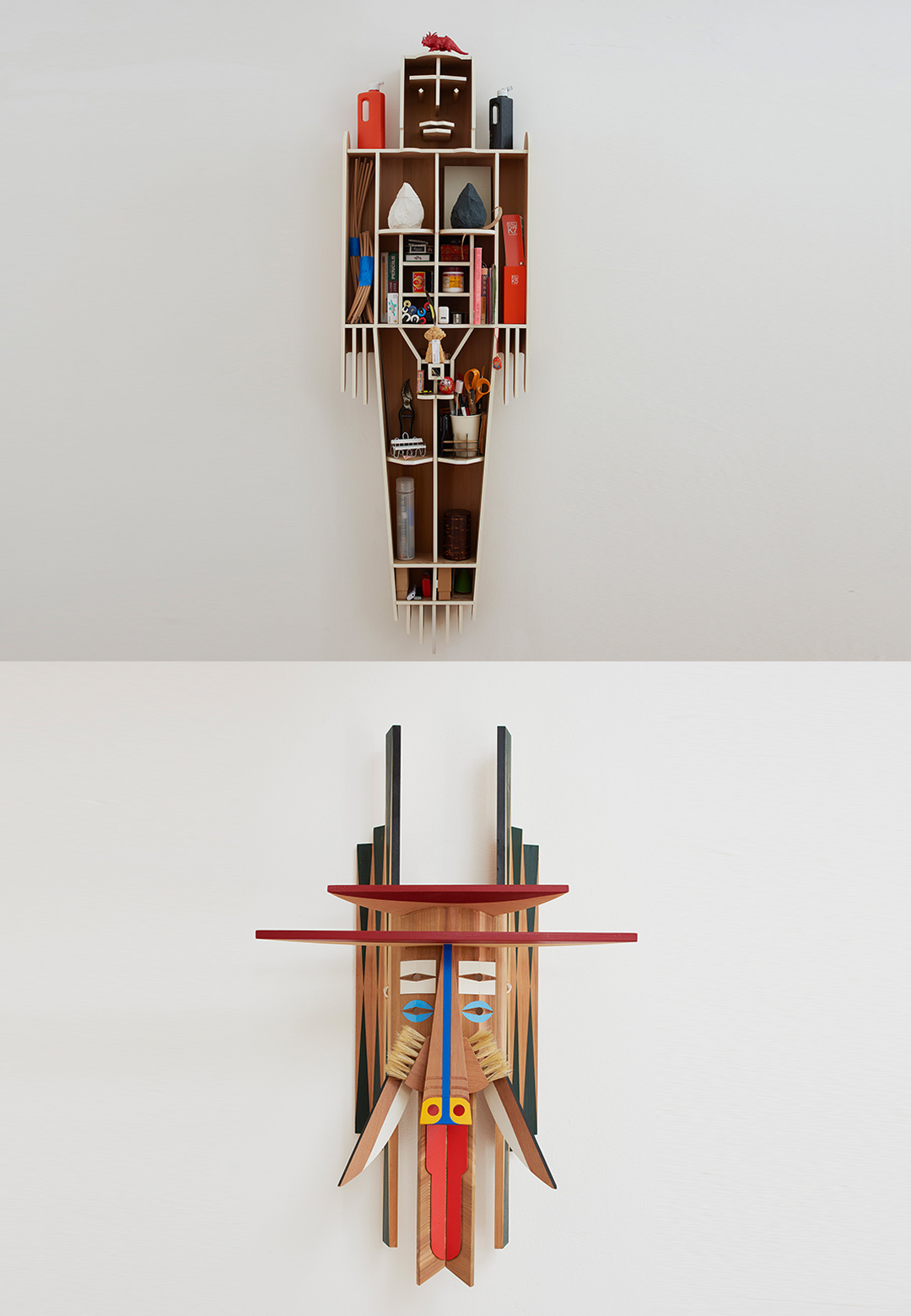Designer and maker Rio Kobayashi deconstructs common objects from Japanese culture, and his life in London, combining them to create colourful and humorous design entities. These vibrant objects evince multilayered narratives, some of which are personal, while others are cultural. His hand-crafted pieces are configured simply, hinting towards the clarity of his thoughts and clean ideation process. Whether it is a piece of furniture or a decorative object, each component holds a purpose evidently, which is either functional or adequately decorative. The product designer expresses an array of emotions through his creations, that are not extensively ornamented or clad in textures and features that hold no charm beyond their representational value. On the contrary, Kobayashi’s objects can be enjoyed for the novel juxtaposition of myriad shapes, colours, and textures. Additionally, they reveal deeper meanings upon closer inspection, glimpsing into the visceral ideas that have guided their designs.
Upon tracing the influences that have shaped Kobayashi’s practice as a designer, one comes across his elementary experiences—the designer was born and raised in a ceramic artisan family in the Tochigi Prefecture in Japan. A creative who tinkered around to create furniture at an early age, Kobayashi left for Austria when he turned 18, to hone his skills in carpentry. Over the course of the next three years, the designer gained an understanding of traditional cabinet-making through his apprenticeship. Later, he worked with various international studios in Milan, Tokyo, Paris, and Berlin. The Japanese designer went on to set up his own workshop in East London in the UK, and has since then, exhibited his works at the London Design Festival, Milan Design Week, Victoria and Albert museum, and many more respected galleries and events across Europe. The designer is also part of the upcoming exhibition Manus Manum Lavat (One hand washes the other), scheduled to be displayed during the London Design Festival 2023, from September 16 to 24, 2023. Part of the Brompton Design District, the exhibition will highlight his appreciation for relationships and collaborative work, with the display of an array of objects that are designed and built by Kobayashi in collaboration with other artists and designers.
'Broad in scope, yet precise in its execution,’ Kobayashi’s work embodies a dialogue between the traditional crafts specific to Japan, and the freedom that modern modes of designing and creating offer. His experiences in different countries as well as the influence of his Japanese and Austrian-Italian parents exposed him to rich cross cultures and myriad traditions. These ideas, specific to the many cultures experienced by him, inform his humorous oeuvre.
Some product designs by the Japanese maker include the 'Hato Vase I, II and III'; the 'Zig Zag Credenza' cabinet; the playful 'Head Shelf'; the 'Chariotte Periond Shelf,' inspired by the Bibliothèque shelves by Charlotte Perriand; the 'Ohana Trivet,' decorative wooden flower petals; the 'Paper Mobile' and 'Chiro Chiro Mobile,' both kinetic sculptures; the 'Rorrim Rorrim,' a unique mirror piece; the 'Positive Chair,' made using an old broken 'Thonet' chair; and the Shoji collection, comprising a wall lamp, screen, chest of drawers, and shelving inspired by Japanese shoji paper sliding doors and screens.
To understand the Japanese maker’s craft further, STIR looks at some of his novel creations and the inceptive ideas that guided their designs.
Shima Uma
'Shima Uma' designed by Rio Kobayashi for Dolce & Gabbana, is a dresser. The name of the piece is derived from the Japanese word for zebra, which literally translates to a striped horse. “I chose this name because I love the ambiguity of the zebra's black and white stripes, which are never quite black or white, but always somewhere in between. This reflects the boundaryless nature of my piece, which appears chaotic at first glance but is meticulously designed and crafted with incredible attention to detail,” the furniture designer shares. A combination of different materials, namely gold-plated glass, a wood structure and marquetry, and a colourful and soft embroidered silk fabric that hangs on the side, 'Shima Uma' presents a balanced blend of furniture and fashion, and hence, a perfect fit for Dolce & Gabbana. Speaking about the dresser that holds cultural motifs, Kobayashi elaborates, “My dresser reflects my own memories of youth and passion, as well as the unique blend of cultures and traditions that shaped my upbringing.”
The Mikado collection
The Mikado collection, inspired by the famous table game ‘Mikado,’ also known as pick-up sticks, comprises a shelf, a table design, a bench, a stool design, a dining chair, a lounge chair, chopsticks, and footsteps. Made out of ashwood painted in acrylic colours and later varnished, the sleek components that make up the furniture designs mirror the fragile balance of the game. “While Kobayashi is profoundly interested in craftsmanship, he also loves to play with the east and west clichés and took the story of the 'Mikado' game and ‘made some fun furniture pieces’ out of it. Even though the game has a Japanese name, it was invented by a clever European company and introduced as a popular game from the far east in the 20th century,” reads an excerpt from the press release. While the joints of the furniture pieces are precisely glued together to ensure delicacy and sturdiness, the boards of the benches, chair designs, tables, and shelves rest on the dowels.
The Robot collection
The Robot shelf is a sculptural piece by Kobayashi that 'combines the robotic and the human, the male and the female, the dead and the living and home storage and artful crafts.’ The idea of making this shelf emerged from the realisation that shelves usually reflect the personality of their owners and users. This thought inspired the designer to create a shelf with its own novel personality. From its legs to its hands, toes, fingers, face, arms, and torso, the shelf holds all the features of a human body. When viewed from different angles, one can witness the various expressions and personalities of the shelf. Made by hand out of red cedar that the designer sanded to ensure smoothness, the wooden shelf was left untreated in order to attain a natural look, feel, and patina.
Kaijyu Mask
Made using red cedar and pig’s hair, the 'Kaijyu Mask' is the result of Kobayashi’s contemplation, on the various aspects that we tend to soak up as we move through life. “The mixture of influences and experiences makes us unique and they help contribute to the construct of our personality. In the strive to be oneself, one tries to be authentic, where the mask one wears should be a reflection of how one really feels,” he shares. Through the mask, Kobayashi aims to express the influence of his Japanese heritage as well as the experiences he has had living in Europe. It manifests, hence, in the form of a colourful entity that can be affixed on the wall as a reminder of the multitudinous characteristics that assimilate to make a person.
Fish Table or Fatty Tuna
Kobayashi’s 'Fish Table' or 'Fatty Tuna' is an oakwood table hand-painted by James Hague in acrylic colours. It was envisioned as part of a larger series of furniture in the shape of different food items. However, this continues to remain the designer’s lone piece of furniture design inspired by food. “The idea of making a dining room table emerged when I was thinking about people coming together at a dining room table—When another person joins a number of people sitting around a table, their conversation will change according to the unique qualities and interests the newcomer will bring with them, just like adding another ingredient to a dish one is cooking will change the overall flavours,” reads the description shared by Kobayashi. However, the choice of fish as the leading ingredient was inspired by Kobayashi’s memories, of time spent in a shared studio with James Hague, a portrait painter and a fishing aficionado. Reminiscing on his time with Hague, the designer remembers him coming home from fishing and making beautiful fish paintings. This fond memory and the desire to collaborate with the painter led the Japanese maker to create a table design that could hold Hague’s dreamy painting.
Nancy’s Table
Built for Victoria and Albert Museum’s exhibition titled R for Repair, Kobayashi’s 'Nancy’s Table' is made using an old sewing chest that belonged to the owner’s grandmother named Nancy. Kobayashi mended the broken chest and combined it with walnut, sapele, ash, glass, and acrylic paint, to manifest the table. Kobayashi attempted to understand the history of the piece before attributing different characteristics to it—For instance, conversations with the owner revealed that Nancy would hide her artwork within the chest. In a way, it was a closet where she also contained her dream of becoming an artist. To honour her dream, Kobayashi decorated the centre of the table with a small painting made by Nancy. He then extended its legs using Japanese joinery techniques, to ensure its function as a table design. To bluntly showcase the newer interventions of the table, the designer made use of other types of wood, in a way where one could differentiate and distinguish them from its older counterparts.
The Diary Furniture collection
Kobayashi first built the 'Diary Shelf' during the first COVID-19 lockdown (on May 5, 2020, to be precise). During this period, he was limited to his flat in London with its little garden, adjacent to his living quarters. With only a few tools at his disposal, there was little work that the designer could do. After spending the first few weeks of the pandemic doing nothing, he finally began to make a few improvements to his home, and finally, created this simple, cross-jointed, wall-mounted shelf, using solid cherry wood. The designer wanted 'to remember this unusual moment and write down every single thought (he) had in a diaristic motion.’ Hence, summoning his calligraphy skills, Kobayashi imprinted his daily thoughts on the shelf in the Japanese script. “It is personal, nonserious writing that nonetheless gives the viewer a sense of gravity, resembling the wooden sticks with elaborate inscriptions that can be found on Japanese graves, called sotōba (卒塔婆). "The 'Diary Shelf' is a work of contrasts, publicly displaying Kobayashi’s private diary and the dialogue between European and Japanese culture,” the designer relays. A few months later, he created another variation of the shelf for Milan Design Week and imprinted it with thoughts that came to his mind at the moment of creation, including the stress and pressure he felt due to the impending deadline.
Zaru Colander
The 'Zaru Colander' comprises a series of foldable colanders and strainers. Zaru (笊) is a Japanese draining basket made from bamboo, used as a straining device, and as a serving tool for Soba, traditional Japanese noodles made from buckwheat in Japan, and for draining pasta in the West. “I was keen to create a colander that doesn’t take up too much space in my small kitchen with limited storage space,” explains the designer. This led to the creation of 'Zaru,' which comes in three different sizes and is collapsible. While the smaller colander is made using cherry wood, the medium-sized one is crafted from walnut, while the large colander is made from beech. The wooden pieces were first steamed and bent, and later on joined, using red and black ball knob screws. One can loosen or tighten the screws to expand or collapse the colanders.






 Sign in with email
Sign in with email










What do you think?